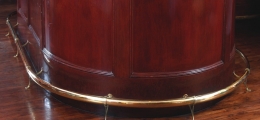Buffet restaurants remain popular with the public because people get a variety of good food at affordable prices. As appealing as these restaurants are, they can also be havens for germs and infections if certain safety guidelines are not followed. You can keep your own buffet restaurant safe and sanitary by following these five important food safety tips.
Most states require buffet restaurants to install food shields and sneeze guards over the buffet lines.
Install a Food Shield/Sneeze Guard
The trays and containers of food on your buffet may tempt any palate. However, it may not be safe to eat if it is not guarded well by a food shield or a sneeze guard. Most states require buffet restaurants to install food shields and sneeze guards over the buffet lines.
These shields must be the height of the average consumer, or about five to six feet tall. They also cannot be movable by either the staff or the customer for the safety of the general public. Along with installing food shields and sneeze guards, you should also remember to have them washed with diluted bleach on both sides before and after the restaurant closes each day.
Keep All Surfaces Clean and Disinfected
Germs can travel fast around your restaurant. When you, an employee, or a customer touches an infected surface, the germs can be transmitted quickly to other surfaces and eventually to the food that you are serving.
You can prevent the transmission of dangerous germs like bacteria, viruses, and fungi by keeping all of the surfaces in the restaurant clean and disinfected at all times. You should use diluted bleach or cleaning disinfectants that are approved by your local food inspector. You should also have employees wipe down the surfaces regularly throughout each shift.
The surfaces to be cleaned include the tables on which the customers eat as well as the chairs, sinks in the bathroom, and condiment and utensil trays. Restaurant-grade cleaning products and diluted bleach can keep surfaces clean and disinfected for several hours after they are used.
Be Mindful of Safe Food Temperatures
Another important safety tip to use every day at your buffet restaurant involves keeping all of the food at safe food temperatures. Health inspectors will check to make sure the food on the buffet is at the right serving temperature. If it is too high or too low, it could make diners sick.
You also may incur an expensive fine from the health inspector. You can avoid ill customers and an expensive fine by keeping cold foods at 40 degrees Fahrenheit or colder. The cold food should be served in chilled containers or in trays or bowls that are filled with ice.
Hot foods should be kept at 165 degrees Fahrenheit or hotter. They should be served in hot chafing dishes, slow cookers, or warming trays.
You should check the temperature of the food on your buffet every two hours. Any food that is at room temperature and left out for at least two hours should be thrown away immediately. The containers should be cleaned thoroughly with bleach before new food is put and served in them.
Wash All Kitchen Utensils to Prevent Cross Contamination
The utensils used in the kitchen can contribute to cross contamination if they are not washed frequently throughout the day. Utensils like knives, spoons, tongs, and others should be washed after they come into contact with raw meat. They should also be washed after they touch dirty surfaces like an unwashed counter.
Utensils that are brought from the buffet line to the kitchen should likewise be cleaned thoroughly. Washing the utensils often during each shift prevents them from contaminating food and passing along illnesses to the customers.
Install Hand Washing Stations for Employees
Finally, as the owner or manager of a buffet restaurant, it is critical that you urge your employees to wash their hands frequently during each shift. They should wash their hands after cleaning or busing a table, using the restroom, blowing their noses, coughing, eating, and smoking a cigarette.
If in doubt, employees should always opt for washing their hands to prevent the spread of germs. Hand washing stations set up in the kitchen, server areas, bathrooms, and front line can prevent contamination of food and stop the spread of germs that can cause serious illnesses.
These five food safety tips can go a long way in keeping your buffet restaurant safe and sanitary. You can have the peace of mind in knowing that the food you serve is safe to eat and that your customers and employees are well-protected from contaminants that can make them sick.
TAGS: restaurants, food, food shields & sneeze guards, safety




















